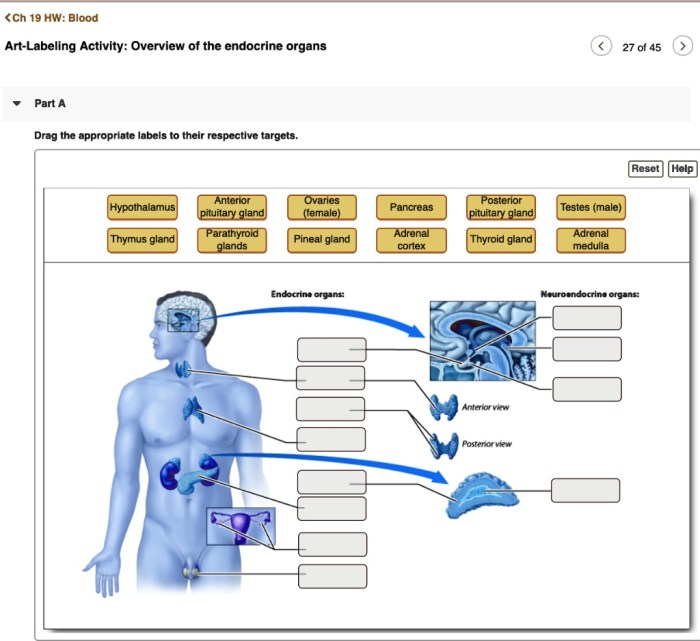The art-labeling activity overview of the endocrine organs presents an engaging and effective approach to learning about the complex system of glands and hormones that regulate various bodily functions. By combining art and science, this activity fosters a deeper understanding of the endocrine system’s anatomy and physiology.
Throughout this overview, we will explore the types of art-labeling activities, the materials and preparation required, and the benefits they offer. We will also provide practical tips for implementation, examples of activities, and frequently asked questions to ensure a successful and enriching learning experience.
Introduction to Art-Labeling Activities
Art-labeling activities are a valuable tool in the study of the endocrine organs. By engaging students in the visual and creative process of labeling anatomical structures, these activities enhance understanding, improve memory, and foster engagement.
Types of Art-Labeling Activities

Various types of art-labeling activities can be used to teach about the endocrine organs:
- Diagram labeling:Students label diagrams of the endocrine organs, identifying their major structures.
- Anatomical model creation:Students create 3D models of the endocrine organs using materials like clay or papier-mâché.
- Anatomical illustration:Students draw detailed illustrations of the endocrine organs, focusing on their anatomical features.
Materials and Preparation for Art-Labeling Activities
Art-labeling activities require the following materials:
- Anatomical diagrams or models of the endocrine organs
- Art supplies (e.g., pencils, markers, paints)
- Anatomical references (e.g., textbooks, online resources)
Preparation involves:
- Gathering materials
- Setting up a workspace
- Familiarizing students with the anatomical structures
Implementing Art-Labeling Activities

To implement art-labeling activities:
- Introduce the activity:Explain the purpose and benefits of the activity.
- Facilitate student participation:Guide students as they label the structures.
- Assess understanding:Use the labeled diagrams or models to assess student comprehension.
Benefits of Art-Labeling Activities

Art-labeling activities provide numerous benefits:
- Improved comprehension:Labeling helps students visualize and understand the anatomical structures.
- Enhanced visual memory:Creating visual representations improves memory retention.
- Increased engagement:Art-based activities engage students and make learning more enjoyable.
Tips for Effective Art-Labeling Activities
For effective art-labeling activities:
- Differentiate:Adjust the activities to suit different learning styles.
- Accommodate diversity:Provide alternative materials for students with disabilities.
- Foster collaboration:Encourage students to work together and share knowledge.
Examples of Art-Labeling Activities: Art-labeling Activity Overview Of The Endocrine Organs
| Activity | Description | Benefits |
|---|---|---|
| Endocrine Organ Diagram Labeling | Students label diagrams of the endocrine organs, identifying their major structures. | Enhances comprehension and visual memory. |
| Endocrine Organ Model Creation | Students create 3D models of the endocrine organs using materials like clay or papier-mâché. | Promotes spatial understanding and tactile learning. |
| Endocrine Organ Anatomical Illustration | Students draw detailed illustrations of the endocrine organs, focusing on their anatomical features. | Encourages precision and attention to detail. |
| Endocrine Organ Bingo | Students match labels to images or descriptions of endocrine organs. | Provides a fun and interactive way to review. |
FAQ
What are the benefits of using art-labeling activities in education?
Art-labeling activities enhance comprehension, improve visual memory, increase engagement, and foster collaboration.
What types of art-labeling activities can be used for teaching about the endocrine organs?
Labeling diagrams, creating anatomical models, drawing illustrations, and using digital labeling tools are common types of art-labeling activities.
How can art-labeling activities be differentiated to accommodate diverse learning styles?
Activities can be differentiated by providing varying levels of support, using multisensory materials, and incorporating technology to cater to different learning preferences.